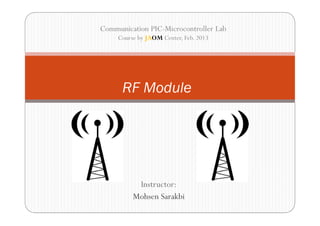
RF module
- 1. Communication PIC-Microcontroller Lab Course by JAOM Center, Feb. 2013 RF Module Instructor: Mohsen Sarakbi
- 3. Data Forms Data (Information) can be analog or digital. The term analog data refers to information that is continuous; digital data refers to information that has discrete states. Analog data take on continuous values. Digital data take on discrete values. In communication systems, we commonly use periodic analog signals and non-periodic digital signals
- 4. Signal Parameters x (t) = A(t) cos[w.t + (Ø)]
- 5. Signal Parameters Amplitude (A): is the peak of the signal
- 6. Signal Parameters Frequency (F): is the rate of change with respect to time. Change in a short span of time, means high frequency. Change over a long span of time means low frequency.
- 7. Signal Parameters Phase (P): describes the position of the waveform relative to time 0.
- 8. Modulation To be transmitted, Information (Data) must be transformed to electromagnetic signals, with higher frequency and power.
- 10. Modulation, Why? Frequency Assignment Reduction of noise/interference Multiplexing Bandwidth limitations of equipment Frequency characteristics of antennas Atmospheric/cable properties
- 11. Modulation Analogue modulation: A higher frequency signal is generated by varying some characteristic of a high frequency signal (carrier) on a continuous basis. Amplitude Modulation (AM), Frequency Modulation (FM), Phase Modulation (PM) Digital modulation: Signals are converted to binary data, encoded, and translated to higher frequency. Frequency Shift Keying (FSK), Binary Phase Shift Keying (BPSK) [ (GMSK)], Quadrature Phase Shift Keying (QPSK), Quadrature Amplitude Modulation (QAM)
- 16. Comparisons of Digital and Analog Communication Systems Digital Communication System Analog Communication System Advantage : Disadvantages : inexpensive digital circuits privacy preserved (data encryption) expensive analog components : L&C can merge different data (voice, video and data) no privacy and transmit over a common digital can not merge data from diff. sources transmission system no error correction capability error correction by coding Disadvantages : Advantages : larger bandwidth smaller bandwidth synchronization problem is relatively difficult synchronization problem is relatively easier
- 17. Time Domain vs. Frequency Domain
- 18. Time Domain vs. Frequency Domain
- 19. Manchester Encoding It is a form of binary phase-shift keying (BPSK) that has gained wide acceptance as the modulation scheme for low- cost radio-frequency (RF) transmission of digital data. Manchester is a simple method for encoding digital serial data of arbitrary bit patterns without having any long strings of continuous zeros or ones, and having the encoding clock rate embedded within the transmitted data. These two characteristics enable low-cost data-recovery circuits to be constructed that can decode transmitted data with variable signal strengths from transmitters with imprecise, low-cost, data-rate clocks.
- 21. RF TX/RX Module
- 22. Specifications Range in open space(Standard Conditions) : 100 Meters RX Receiver Frequency : 433 MHz RX Typical Sensitivity : 105 dBm RX Supply Current : 3.5 mA RX IF Frequency : 1MHz Low Power Consumption Easy For Application RX Operating Voltage : 5V TX Frequency Range : 433.92 MHz TX Supply Voltage : 3V ~ 6V TX Out Put Power : 4 ~ 12 Dbm
- 23. PIN Layout
- 24. Decoders - Encoders Parallel encoders/decoders 4bits: HT12D / HT12E 8bits: CIP-8
- 25. HT12D Decoder Features: Operating voltage: 2.4V~12V Low power and high noise immunity CMOS technology Low standby current Capable of decoding 12 bits of information Binary address setting Received codes are checked 3 times Address/Data number combination 8 address bits and 4 data bits
- 26. HT12E Encoder Features: Operating voltage 2.4V~12V Low power and high noise immunity CMOS technology Low standby current: 0.1A (typ.) at VDD=5V Four words Built-in oscillator needs only 5% resistor Data code has positive polarity
- 27. PIN Layout
- 28. CIP – 8bits Decoder/Encoder Features: Latched or momentary outputs No programming necessary Very easy to use Very low component count Low current consumption Up to 25mA per decoder output Eight bit data (D0 to D7) Eight bit binary address (0 to 255) Selectable baud rates (2400/4800) High noise immunity Standard 20-pin PDIP package
- 29. PIN Layout Note: All pins must be connected
- 30. Lab Test RF modules Application without PIC Application with PIC
